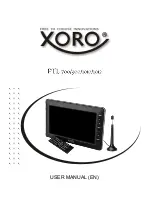
2
(
3
)
Do not use undersized, worn, damaged or bare
wired cables.
(
4
)
Connect cables completely and insulate connection
parts.
(
5
)
Keep all cases, panels and covers securely in place.
(
6
)
Do not handle the welding power source with torn or
wet gloves.
(
7
)
Wear safety harness in case of working above floor
level.
(
8
)
Turn off all equipment when not in use.
(
9
)
Perform periodic checks without fail and repair or
replace any damaged parts before using the power
source.
(
10
)
In case of AC arc welding in a confined area or
above floor level, check related national, state and
local codes and regulations for any special treatment
and comply with it if any.
Ventilation and protective equipment
(
1
)
When conducting welding in the bottom of the tank,
boiler or hold as well as legally-defined sites, use a
local exhauster specified by the applicable laws and
regulations (occupational safety and health
regulation, rules on preventing suffocation or etc.) or
wear protective breathing gear.
(
2
)
To prevent dust injury or poisoning by the fume
generated during welding, use a local exhauster
specified by the applicable law (occupational safety
and health regulation, rules on preventing injury by
inhaled dust or etc.), or wear protective breathing
gear.
(
3
)
When conducting welding in a confined area, make
sure to provide sufficient ventilation or wear
protective breathing gear and have a trained
supervisor observe the workers.
(
4
)
Do not conduct welding at a site where degreasing,
cleaning or spraying is performed. Conducting
welding near the area where any of these types of
work is performed can generate toxic gases.
(
5
)
When welding a coated steel plate, provide sufficient
ventilation or wear protective breathing gear.
(Welding of coated steel plates generates toxic fume
and gas.)
Against fire, explosion or blowout
(
1
)
Remove any combustible materials at and near the
work site to prevent them from being exposed to the
spatter. If they cannot be relocated, cover them with
a fireproofing cover.
(
2
)
Do not conduct welding near combustible gases.
(
3
)
Do not bring the hot base metal near combustible
materials immediately after welding.
(
4
)
When welding a ceiling, floor or wall, remove all
flammables including ones located in hidden places.
(
5
)
Properly connect cables and insulate connected
parts. Improper cable connections or touching of
cables to any electric current passage of the base
metal, such as steel beam, can cause fire.
(
6
)
Connect the base metal cable at a section closest to
the welding part.
(
7
)
Do not weld a sealed tank or a pipe that contains a
gas.
(
8
)
Keep a fire extinguisher near the welding site for an
emergency.
Installing shielding (curtain etc.)
(
1
)
When welding or monitoring welding, wear safety
glasses with sufficient light blocking performance or
use a protective mask designed for welding
operation.
(
2
)
Wear protective glasses to protect your eyes from
spatter or slugs.
(
3
)
When welding or monitoring welding, wear protective
clothes designed for welding operation, such as
leather gloves, leg cover and leather apron, and also
wear long-sleeve shirts.
(
4
)
Install a protective curtain around the welding
manipulator site to prevent the arc flash from
entering the eyes of people in the surrounding area.
Gas cylinder and gas flow regulator
(
1
)
The gas cylinder must be handled properly
according to the applicable law and in-house
standards.
(
2
)
Use the gas flow regulator that is supplied or
recommended by our company.
(
3
)
Read the instruction manual of the gas regulator
prior to using it, observe the cautions in the manual
(
4
)
Secure the gas cylinder to a dedicated gas cylinder
stand.
(
5
)
Do not expose the gas cylinder to high temperature.
(
6
)
When opening the valve of the gas cylinder, do not
bring your face close to the discharge outlet.
Oxygen deficit, fume and gas generated
during welding can be hazardous.
Observe the following cautions to prevent
fires explosion or blowout.
CAUTIONS
Arc flash, flying spatter and slugs generated
during welding can damage your eyes, skin
and hearing.
Overturn of gas cylinder and blowout of
gas flow regulator can cause injury.
About safety
Содержание YD-350GL4
Страница 45: ...41 1 2 3 4 5 6 7 8 9 10 11 12 13 14 14 40 41 43 44 45 Right view Left view Parts list ...
Страница 49: ...45 1 2 3 4 5 6 7 8 9 10 11 12 13 14 14 40 41 43 44 45 Right view Left view Parts list ...
Страница 52: ...Circuit diagram 48 13 Circuit diagram 13 1 Circuit diagram for 350GL4 100V 100V Optional parts 300 246 ...
Страница 53: ...Circuit diagram 49 13 1 Circuit diagram for 500GL4 100V 100V Optional parts 300 248 ...







































